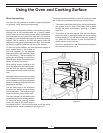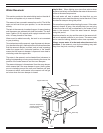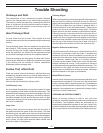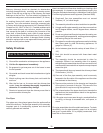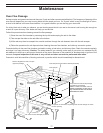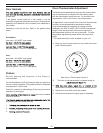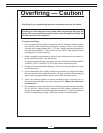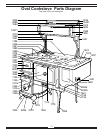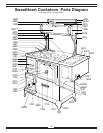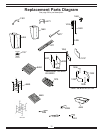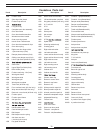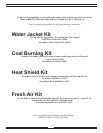
30
Backdrafting—The emission of smoke and/or air through
the stove when a ow reversal occurs in the chimney, caused
by wind conditions or negative pressure within the building.
Backpufng—The momentary emission of smoke through
openings in the stove when oxygen is admitted to an oxygen-
starved re. When a door or the bell dampers are opened,
the sudden charge of air may not be immediately absorbed
by the chimney system, resulting in a backpuff of smoke.
To help eliminate this problem ensure that the oven damper is
open before opening the ash pan or redoor. Open the doors
slowly to allow the smoke to clear from the chimney system.
Bank (the re)—Loading the rebox with fuel (wood or coal) to
produce a long burn cycle. Banking can only be accomplished
on a good bed of coals.
Creosote—When wood is burned slowly, it produces tar and
organic vapours, which combine with expelled moisture to
form creosote.
Creosote vapours condense in the relatively cool chimney
ue of a slow burning re resulting in creosote residue
accumulating on the ue lining. When ignited, this creosote
makes an extremely hot re.
Establish a routine for the fuel, wood burning and ring
technique. Check daily for creosote buildup in the pipe and
chimney until experience shows how often you need to clean
to be safe.
The hotter the re and/or the drier the wood, the less creosote
is deposited. We recommend burning your stove with all the
combustion air dampers open for at least an hour each day.
Weekly cleaning may be necessary in mild weather; monthly
cleaning may be enough in the coldest months.
Key Plate—The cast iron section on the stove top which is
lifted for fuel loading or to make repairs in the rebox.
Key Plate Lift Handle—The handle used to lift the key plate
to allow access to load the rebox.
Lid—The removable round cast iron disks on the stove top.
Can be removed to allow access to clean the ue chamber
above the oven.
Lid Lifter—The tool used to remove the lids, open and close
the rebox doors, and adjust the bell and oven dampers (see
gure 8).
Oven Cleanout Door—The door under the oven that is
removable to allow access to scrape ashes out of the ue
passage around the oven.
Oven Damper—The shutoff for routing the heat smoke and
gases either directly out through the ue or around the oven.
When ‘open’ the smoke, heat and gases will exhaust directly
out the ue. This is the position used during the initial ring
of the stove.
When ‘closed’ the smoke, heat and gases will be routed
around the oven heating the oven, cooking surface and more
of the stove mass. When the oven damper is ‘closed’ more
resistance is put on the chimney system.
Opening any doors or lifting the key plate with the oven damper
closed will result in backpufng. Always open the oven damper
before opening the ash pan door, redoor or key plate.
Oven Flue Passage—The air space around the oven (between
the oven top and the cooking surface, the right side of the
oven and the right side of the stove, and the bottom of the
stove and bottom of the oven) through which heat, smoke
and gases travel.
This resulting travel heats the oven when the oven damper
is in the ‘closed’ position.
Oven Rake—The tool used to scrape creosote and ash from
the ue chamber around the oven.
Warming Cabinet—The storage and warming area mounted
to the base of the stove. Provides overhead storage and
warming for plates and foods. May also be referred to as
warming closet.
Water Jacket—A hollow collector which is installed in the
rebox through which water ows is heated and is circulated to
a storage tank, either by convection ow or by a small pump.
This system may be used for domestic hot water or baseboard
heating. Installation should be carried out only by a qualied
plumber. Ask your dealer, or call or write us for an installation
guide.
Water Reservoir—The water holding tank on the side of
the stove. Water must be added manually. The tank is not
connected to your plumbing.
Woodstove heat is very dry and the water in the reservoir will
add much needed moisture to your home. The warm water
can be used for dishes and other clean up needs.
Terms of Reference and Function



